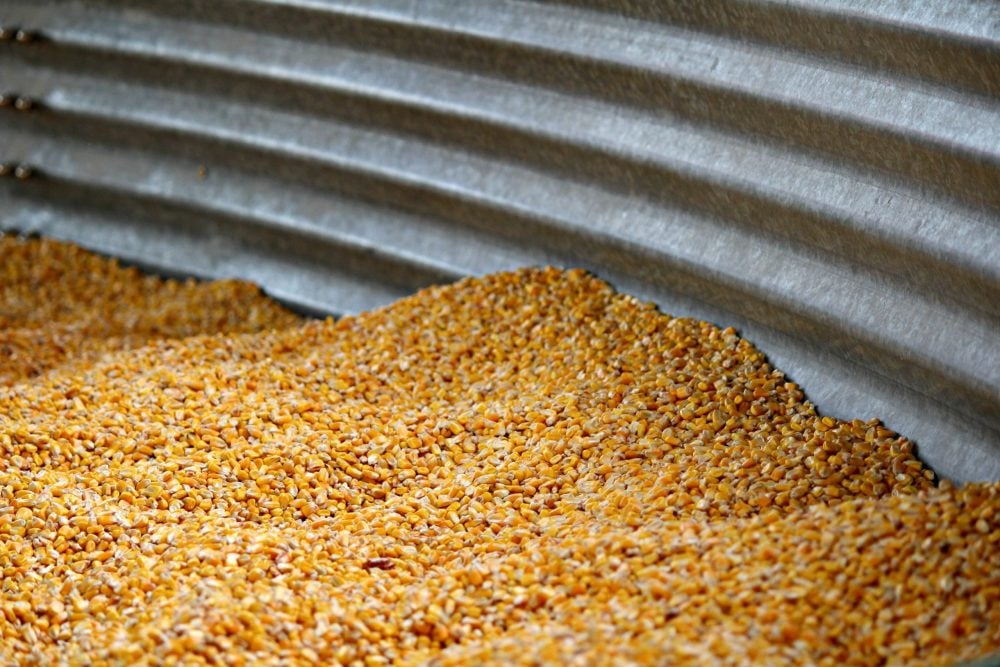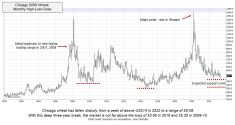South American harvest pressure is weighing on the soybean complex. U.S. corn continues to be the most competitive on the world market as the main Brazilian harvest occurs in April and May. Wheat prices are percolating higher on slower Russian exports and production uncertainty in the Northern Hemisphere winter wheat.
Quick look:
Soybeans: U.S. soybean prices are likely to be depressed if China retaliates to tariffs imposed by the U.S.
Read Also

Cycle swings dictate farming profitability
It can be profitable to understand where the crop markets are positioned in the context of their big-picture cycles.
Corn: Ontario prices will benefit if Mexico places a tariff on U.S. corn.
Wheat: Ontario wheat stocks are expected to drop to historical lows at the end of the 2024/25 crop year
Tariffs alternate trade flows and are inflationary by nature for the country implementing the tariffs. The long-term consequences of Trump’s proposed tariffs and retaliatory responses are difficult to forecast. This reinforces the strategy for selling regular increments of production throughout the crop year to achieve a higher overall average price.
Soybeans
Ontario soybean prices consolidated through January as the domestic crusher kept bids in line with the export market. Ontario soybeans stocks as of Dec. 31 are expected to come in at two million tonnes which included one million tonnes in commercial positions and one million tonnes on farms. The stocks in commercial positions are sufficient to satisfy domestic and export demand from January through March.
Later in spring, the domestic crusher will need to increase bids to attract farmer selling. The Ontario soybean basis is expected to strengthen as the world market digests South American supplies.
At the time of writing this article, Brazilian soybeans were quoted at US$385/tonne f.o.b. Paranagua, while U.S. soybeans were offered at US$417/tonne f.o.b. the Gulf. U.S. exports of soybeans have slowed over the past month as Brazilian soybean offers dominate the world market. Additional pressure is expected as harvest advances.
As of Feb. 1, we estimate that the Brazilian soybean harvest was five per cent complete. Brazil has experienced adverse rains throughout January which has tempered harvest progress and crop development in some regions. Traders continue to estimate the crop in the range of 165-170 million tonnes, up from the year-ago output of 153 million tonnes.
In Argentina, the main soybean harvest occurs in the latter half of March and extends through April. The weather has been quite variable but traders feel comfortable with the USDA estimate of 52 million tonnes, up about 3.8 million tonnes from last year. Argentina is the world’s largest exporter of soyoil and soymeal. Later in spring, the U.S. and Ontario soybean crush margins are expected to deteriorate as Argentinean soybean products dominate the world market.
There is no doubt that China will retaliate to the Trump tariffs and this will depress U.S. soybean prices. In the previous Trump administration, the U.S. government subsidized soybean production. This behaviour caused Ontario soybean prices to drop under $11/bu. as U.S. exports into Ontario depressed prices.
What to do: This week, we’re advising farmers to sell 20 per cent of their 2024 soybean production bringing total sales to 80 per cent. We’re advising farmers to sell 10 per cent of their expected 2025 production. World soybean fundamentals are burdensome for 2024/25 and 2025/26. The tariffs will only be an added weight on the market.
Corn
Ontario corn prices have been relatively flat throughout January. We continue to expect higher prices for Ontario producers later in spring. Ontario corn stocks as of Dec. 31 are estimated at 3.4 million tonnes and commercial stocks are expected to come in at 3.8 million tonnes. Commercial stocks are sufficient to cover domestic and export demand through March. Demand for Ontario corn makes seasonal highs in April and May. Ontario livestock inventories peak during April and May. Export demand to Europe surges during the same period. The market will need to attract farmer selling during the spring which should result in stronger basis.
At the time of writing this article, U.S. corn was offered at US$227/tonne f.o.b. the Gulf. Brazilian corn was quoted at US$238/tonne f.o.b. Paranagua and Argentinean corn was quoted at US$235/tonne f.o.b. Rosario (up river). French corn was valued at US$238/tonne f.o.b. La Pallice. Ontario corn was quoted at US$225/tonne f.o.b. St. Lawrence port. Ontario corn is competitive with U.S. and French corn into Northern European destinations.
Mexico is the world’s largest importer of corn and the largest customer for U.S. origin. Mexico may retaliate to the “Trump tariffs” with a tariff on U.S. corn. Ontario, Brazil and Argentina would receive the benefits of this counter measure.
As of Feb. 1, we estimated that Brazil’s first corn crop was six per cent harvested. The second corn crop will be planted later than normal due to adverse rains. Trade estimates as of Feb. 1 have second corn plantings at two per cent complete compared to a normal pace of 10 per cent. The first crop is estimated at 25 million tonnes and the second crop is projected to reach 102 million tonnes. The second crop harvest will occur in late May or June which includes the bulk of the exportable surplus.
Traders are comfortable the Argentine production forecast of 51 million tonnes, up one million tonnes from last year. The bulk of the Argentine corn harvest occurs during March and April.
Unlike soybeans, the world corn fundamentals for the major exporters are rather tight. Ending corn stocks from the major exporters (Argentina, Brazil, Russia, South Africa, Ukraine, excluding the U.S.) are expected to drop to eight million tonnes, down from the 2023/24 carryout of 9.75 million tonnes and down from the five-year average of 14 million tonnes.
In our previous issue, we mentioned that the U.S. carryout would also finish near the five-year average. The corn futures are expected to incorporate a risk premium due to the uncertainty in Northern Hemisphere production during April. This risk premium could be in the tune of $1.00-$1.50/bu., especially if it’s drier in Brazil and the U.S.This comes at a time when the Ontario basis will strengthen due to stronger export demand.
What to do: We’ve advised farmers to be 50 per cent on their 2024 production. We continue to be very bullish on Ontario corn prices. Plan to make sales in March and April.
Wheat
Ontario wheat stocks are expected to drop to historical lows at the end of the 2024/25 crop year. The market will function to ration demand moving forward. Domestic millers in Ontario will be paying a premium to elevators sourcing for offshore movement.
Russia capped wheat exports from Feb. 1 through June 30 at 11 million tonnes, down from 29 million tonnes last year. The export pace is slowing from the world’s largest exporter. The forecast for February and March calls for below normal precipitation for much of the Russian winter wheat region. This comes on the heels of year-over-year decrease in planted acreage. The wheat market will strengthen due to uncertainty in production in Russian output in spring.
In Europe, much of the winter wheat region has limited or no snow cover. In Germany and central Europe, temperatures are expected to drop to lower levels in February which will result in a larger percentage of winter kill. There are problems developing in Europe. Spain and Southern France are on the drier side, but moisture is sufficient in central France and Germany.
In the U.S. Southern Plains, the hard red winter region is expected to receive below normal precipitation over the next 45 days. Seasonal rains are expected in April but the market will be sensitive to weather after the drier period. If the seasonal rains don’t materialize, the crop will experience below average yields.
Given the lower export pace out of Russia, export demand from the U.S. and Canada is expected to increase in from February through June.
In Western Canada, weather patterns move in 18-year cycles. Below average yields occurred in 2007 due to drier conditions. Remember, the Minneapolis wheat futures made record highs in the 2007/08 crop year. Prices started to rally in June 2007 and never looked back until March 2008. We’re not expecting historical highs in 2025/26 but we’re expecting below average spring wheat yields in Western Canada and the U.S. for the 2025 growing season.
What to do: We’ve advised Ontario producers with feed quality wheat to be 50 per cent sold on their 2024 production. We’re planning on making our next feed wheat sale in April and May when the corn market rallies. Producers with milling wheat are advised to sell 20 per cent of their 2024 production this week bringing total sales to 50 per cent for the 2024/25 crop year. Milling wheat prices in Ontario are at the highest levels of the crop year. We want to sell into this strength. Our next milling wheat sale will occur in late March but it’s prudent to move to 50 per cent sold at this time.















